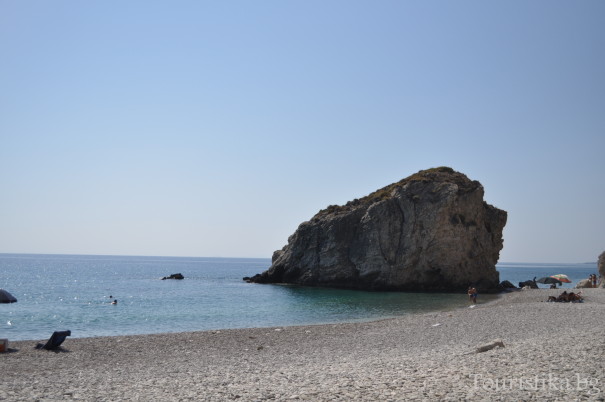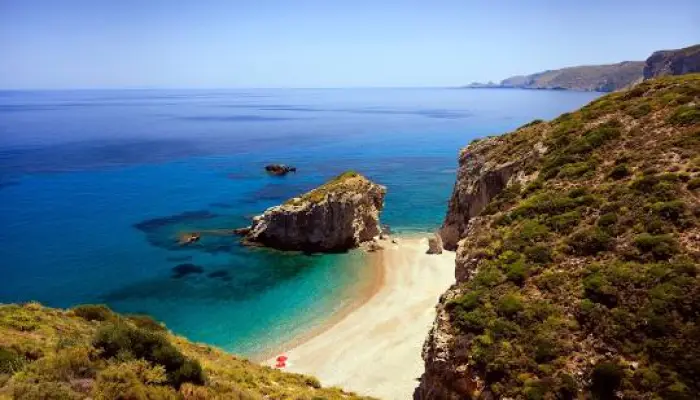Kythira, the smallest of the seven main Ionian Islands of Greece, is often overlooked by Russian tourists. Perhaps because of its relative distance from mainland Russia or because the Greeks prefer to keep this place away from foreign eyes, preserving it in its pristine state away from the tourist hustle and bustle of big resorts.
The words "authenticity," "untouched nature," and "lack of commercialism" best describe Kythira. Traditional houses, pristine beaches, picturesque villages, and friendly smiling locals create the feeling that time stopped here decades ago. There's no modern architecture, towering concrete hotels, shopping centers, attractions, or crowds of tourists. And that didn't bother us at all, quite the contrary...
Beaches

On Kythira, there are so many beaches that you can't visit them all in a week. The sea water is truly crystal clear and amazingly transparent. By midday, it takes on a rich turquoise hue. The most beautiful beach on the east is Kaladi, and on the west is Likodimos. In the south lies Kapsali, the only "organized" beach with umbrellas and sun loungers. Another such beach is the beautiful Melidoni, although as you descend down the black road, it seems like there's no one below. The same goes for the so-called "Good old days" - a marvelous beach amidst the cliffs in the northeast of the island. It's equipped with everything you need, even a cocktail bar. Other picturesque beaches can be found near Diakofti, between Avlemonas and Paleopoli, and in Agia Pelagia. The latter village boasts at least 5 beaches, some of the most beautiful and secluded ones, like Lorenzo and Limani. Half of the beaches are sandy, while the other half consists of fine, perfectly smooth pebbles. Fishermen won't be bored here - small fish are visible with the naked eye right at the shore.
Points of Interest
.jpeg)
- Milopotamos - one of the most authentic places. Bustling streets, cafes, restaurants, a large well-kept church, leisurely locals... Nearby is a small waterfall and the road to one of the largest monasteries on the island.
- Potamos - a bustling market town, bakeries and cafes at every turn, narrow winding streets, and nervous drivers due to the narrowness (though only in the mornings). In the evenings, no one is in a hurry - just Greek salad and glasses of tsipouro (Greek brandy).
- Mylopotamos - straight out of a fairy tale. The serpentine road is lined with cypresses and pines, and you can imagine yourself somewhere in Tuscany. A cozy mountain village, and near the old church awaits "Taverna Michalis" with an idyllic view and atmosphere.
- Chora (the capital) with a Venetian castle on top and white houses looks very romantic. There are friendly hosts in cozy souvenir shops, but there are few restaurants and cafes.
- Kapsali, 2 km from Chora, makes up for the lack of establishments and offers a variety of delicious cuisine in coastal taverns. From the east, there's a wonderful view of the Venetian fortress above Chora. Here you can rent a boat without a captain or join a 2-hour boat trip with a glass bottom.
- Aroniadika - a picturesque village, the road passes right by the windows of ancient white houses.
- In Livadi, the old windmill converted into accommodation is interesting. It must be great to stay there, but it was booked until the end of summer.
- Avlemonas - a pleasant oasis in the rugged untouched part of the island, unlike the green and soft landscape on the other side. In the center are the Baths of Aphrodite, to whom, according to legend, the whole island belongs. In the evenings, there are several taverns, and between Avlemonas and Paleopoli is one of the best - "Scandia".
- Karavas in the picturesque green north. The town is reached by an arch, and it is situated amphitheatrically with a high church bell tower at the top.
- Perlegianika - a cozy village among green hills in the west. Here was our villa with a flowery veranda and an authentic, yet modernly furnished interior.
- Logothetianika - a tiny village near Perlegianika with perhaps the best tavern on the island. If you like a homely atmosphere, a few tables under an old walnut tree at Polina's tavern are just for you. Polina herself cooks amazingly delicious local dishes and serves them with a constant smile. In the courtyard near the old church, colorful lanterns light up by the fountain in the evenings.
How to Get to Kythira

Kythira is somewhat isolated from the other Ionian Islands, just north of Crete. You can get there through Athens and the Peloponnese peninsula with the final destination being the picturesque port town of Neapolis, from where ferries depart.
Along the way, it's worth stopping in other cities of the Peloponnese to see the local architecture and landscapes, for example, in Sparta (the road passes right through it), Corinth, Kalamata. From the Athens highway, there's an exit to Mycenae and numerous archaeological sites. The ferry from Neapolis at 3:00 PM takes 1 hour and 15 minutes to reach Kythira. There is an airport on the island if you don't want to tackle the Greek roads with numerous toll booths. However, wherever you land, a car is necessary for getting around Kythira.
